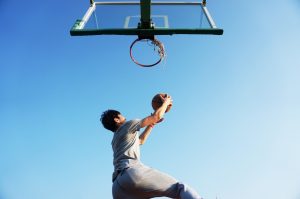Follow Up Questions
(Reminder: should be done after a card is guessed):“¿Les gusta _____________? ¿Por qué sí/no?”
“¿Con qué frecuencia ______________?”
“¿Con quién __________?”
Main Activity
Materials Needed For Main Activity:
Optional Physical Materials:
- Tarjetas de conversación
- Divide the students into 2 groups
Voy a dividir a los estudiantes en 2 grupos - Group 1 will be the sedentary group and group 2 will be the traveling group. Each person in group 1 will be paired with someone from group 2 and stand in two lines facing each other. Students will be set up like they’re “Speed Dating”, one in front of another.
Grupo número 1, Uds. se van a quedar en sus sillas (el grupo sedentario) y grupo número 2 va a ser el grupo viajante. Estudiantes del grupo 1 deben estar en frente de los estudiantes en grupo 2. - Each pair of students will scan the QR code in the presentation or have their own set of activity cards if using physical materials.
Cada pareja va a tener sus propias tarjetas. - Students will introduce themselves and then either choose a new card or draw a physical activity card. They should ask each other questions about the subject and have a casual conversation for 2-3 minutes.
Primero, ustedes necesitan introducirse. Luego, necesitan agarrar una tarjeta de conversación. Después, van a discutir las preguntas y tener una conversación casual por 2 o 3 minutos. - After 2-3 minutes, people in the traveling group (group 2) will rotate, so they have a new partner from group 1.
Después de 2-3 minutos, vamos a cambiar parejas. Grupo 2 cambia una posición con Grupo 1.
Wrap Up
Ask students the following questions to finish the lab:
1. ¿Qué actividades son populares en nuestra escuela? (Which activities are popular in your home?)
2. ¿Participas en un club o un deporte? (Do you participate in a club or a sport?)
3. ¿Qué es algo nuevo que puedes compartir sobre tus compañeros de lab? (What is something new you can share about your lab partner?)
4. Por la mañana, ¿Qué actividades prácticas? Por la tarde? Por la noche? (In the Morning, which activities do you practice? In the Afternoon? At Night?)
5. ¿Cuál es tu serie favorita o película? (What is your favorite series or movie?)
6. ¿Cuál es tu tienda favorita para comprar en línea? (What is your favorite online store?)
7. ¿Qué te gusta hacer cuando no tienes tarea? (What do you like to do when you don’t have homework?)
8. ¿Cuál es tu aplicación favorita entre Facebook, Instagram, Snapchat y Twitter? (What is your app between Facebook, Instagram, Snapchat, and Twitter?)
END OF ACTIVITY:
• Read Can-Do statements once more and have students evaluate their confidence.
(Use thumbs up/thumbs down or download our student cards.)
• Encourage students to be honest in their self-evaluation.
• Pay attention, and try to use feedback for future activities!
NCSSFL-ACTFL Can-Do Statements:
- I can exchange information about what I like to do in my free time with a partner.
- I can ask and answer questions about my hobbies while in a conversation.
- I can share my reasoning for liking/disliking an activity.
Cultural NOtes:
- Spanish: Hobbies and Sports Quizlet
- Deportes En La Ciudad de México
- Día Internacional del Flamenco 2019
How to Revise or Remix a Pathways Project Activity
Feeling creative? The Pathways Project needs your help in revising and remixing activities for the K-16 language classroom.
Try taking an activity to the next level by:
- Add new content (something you’ve created or another OER source)
- Contribute additional activity suggestions
- Integrate authentic materials such as videos, infographics, photos, etc.
- Suggest how to implement the activity in the classroom
- Customize the content for a specific audience or group of learners (for example, K-5 learners or to differentiate for student’s needs)


